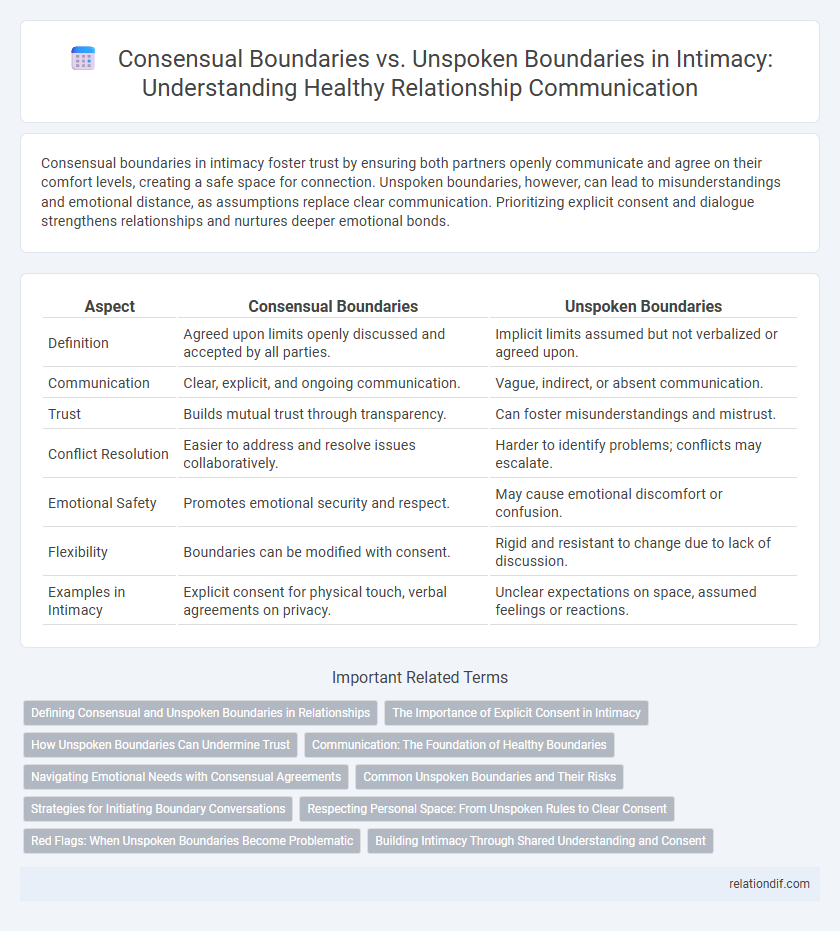Consensual boundaries in intimacy foster trust by ensuring both partners openly communicate and agree on their comfort levels, creating a safe space for connection. Unspoken boundaries, however, can lead to misunderstandings and emotional distance, as assumptions replace clear communication. Prioritizing explicit consent and dialogue strengthens relationships and nurtures deeper emotional bonds.
Table of Comparison
| Aspect | Consensual Boundaries | Unspoken Boundaries |
|---|---|---|
| Definition | Agreed upon limits openly discussed and accepted by all parties. | Implicit limits assumed but not verbalized or agreed upon. |
| Communication | Clear, explicit, and ongoing communication. | Vague, indirect, or absent communication. |
| Trust | Builds mutual trust through transparency. | Can foster misunderstandings and mistrust. |
| Conflict Resolution | Easier to address and resolve issues collaboratively. | Harder to identify problems; conflicts may escalate. |
| Emotional Safety | Promotes emotional security and respect. | May cause emotional discomfort or confusion. |
| Flexibility | Boundaries can be modified with consent. | Rigid and resistant to change due to lack of discussion. |
| Examples in Intimacy | Explicit consent for physical touch, verbal agreements on privacy. | Unclear expectations on space, assumed feelings or reactions. |
Defining Consensual and Unspoken Boundaries in Relationships
Consensual boundaries in relationships are explicitly communicated limits agreed upon by all parties, fostering mutual respect and trust. Unspoken boundaries, often based on intuition or past experiences, can lead to misunderstandings due to their implicit nature. Defining and regularly discussing consensual boundaries enhances clarity, reduces conflict, and strengthens emotional intimacy between partners.
The Importance of Explicit Consent in Intimacy
Explicit consent in intimacy ensures clear communication, fostering trust and respect between partners while preventing misunderstandings and emotional harm. Clearly defined boundaries promote mutual comfort and empower individuals to express their needs and limits confidently. Prioritizing explicit consent contributes to healthier relationships and reinforces personal autonomy in intimate experiences.
How Unspoken Boundaries Can Undermine Trust
Unspoken boundaries in intimate relationships create ambiguity, leading to misunderstandings and unmet expectations that erode trust over time. Without clear communication, partners may inadvertently cross personal limits, causing emotional distress and a sense of betrayal. Establishing and respecting consensual boundaries safeguards trust by fostering transparency and mutual respect in intimate connections.
Communication: The Foundation of Healthy Boundaries
Consensual boundaries in intimate relationships rely on clear, open communication where partners explicitly express their limits and desires, fostering mutual respect and trust. In contrast, unspoken boundaries can lead to misunderstandings and emotional distance, as assumptions replace honest dialogue. Establishing healthy boundaries through communication ensures that both parties feel safe, valued, and understood, strengthening the emotional connection.
Navigating Emotional Needs with Consensual Agreements
Consensual boundaries in intimacy prioritize clear communication and mutual agreement, enabling partners to navigate emotional needs with respect and understanding. Unspoken boundaries often lead to misunderstandings and emotional disconnect, emphasizing the importance of explicit discussions to align expectations. Establishing consensual agreements fosters trust, emotional safety, and deeper connection within relationships.
Common Unspoken Boundaries and Their Risks
Common unspoken boundaries in intimacy, such as personal space, emotional vulnerability, and physical touch limits, often lead to misunderstandings when not openly communicated. Risks include emotional discomfort, trust erosion, and unintended breaches that may harm the relationship. Establishing clear, consensual boundaries prevents confusion and fosters a safer, more respectful intimate connection.
Strategies for Initiating Boundary Conversations
Establishing consensual boundaries requires clear communication strategies such as using open-ended questions and active listening to ensure mutual understanding. Initiating boundary conversations can involve expressing personal needs and emotions honestly while encouraging partners to share their own limits without fear of judgment. Regularly revisiting these discussions helps maintain trust and respects evolving comfort levels in intimate relationships.
Respecting Personal Space: From Unspoken Rules to Clear Consent
Respecting personal space in intimacy requires distinguishing between unspoken boundaries, which rely on subtle cues and assumptions, and consensual boundaries that are explicitly communicated and agreed upon. Clear consent enhances trust and comfort, ensuring both partners feel safe and valued without ambiguity. Prioritizing open dialogue about limits transforms intimacy into a mutually respectful experience grounded in understanding and care.
Red Flags: When Unspoken Boundaries Become Problematic
Unspoken boundaries in intimate relationships often lead to misunderstandings and emotional distress, signaling potential red flags such as resentment, mistrust, or anxiety. Consensual boundaries, clearly communicated and respected by both partners, foster a safe environment for vulnerability and connection. Ignoring these explicit agreements or assuming unvoiced limits risk eroding intimacy and causing long-term relational damage.
Building Intimacy Through Shared Understanding and Consent
Establishing consensual boundaries fosters trust and emotional safety, which are essential for deepening intimacy between partners. Shared understanding through open communication prevents misunderstandings and respects individual comfort levels, creating a foundation of mutual respect. Emphasizing explicit consent transforms intimacy into a collaborative experience that strengthens connection and encourages vulnerability.
Consensual boundaries vs unspoken boundaries Infographic

 relationdif.com
relationdif.com